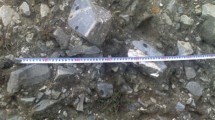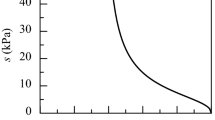Abstract
Fracture characteristics of cement-stabilized soil under Mode I (tensile) and Mode II (in-plane shear) were investigated on a series of cube specimens. The linear elastic fracture mechanics approach was applied to study the stress distribution in the specimens and also to determine the constitutive equations for fracture parametersK I andK II. The experimental studies were carried out on a range of 100 mm soil-cement cube specimens modified for fracture testing by inserting a series of slots. It was shown that results predicted by numerical models were in acceptable agreement with the experimental observations. The fracture parameterK I was found to be in the range 0.11–0.17 MN m−3/2 and the parameterK II in the range 0.31–0.45 MN m−3/2. This result indicated that the soil-cement exhibited a greater resistance to shear fracture than was expected.
Similar content being viewed by others
Abbreviations
- K :
-
Stress intensity factor
- σ:
-
elastic stress field near the crack tip
- f(a/w) :
-
Dimensionless parameter depending on geometries of the specimen and the crack
- r :
-
Radial distance measured from the crack tip
- U :
-
Area under load-deflection graph
- dU :
-
Difference in potential energy for unit thickness between two identically loaded bodies
- dA :
-
Increase in crack area
- G :
-
Strain energy release rate
- E :
-
Young's modulus
- v:
-
Poisson's ratio
- a :
-
Crack length
- w :
-
Specimen width
- B :
-
Specimen thickness
- H :
-
Slot separation
- σy :
-
Yield stress of material
- K I,K II :
-
Fracture toughness in Mode I, Mode II
- P :
-
Applied load
- P max :
-
Load at failure
- τ:
-
In-plane shear stress
References
G. R. Irwin, “Fracture mechanics” (Pergamon Press, 1960) pp. 557–92.
M. F. Kaplan,J. A.C.I. 58 (1961) 591.
Z. Bazant,Mater. Construct. 16 (93) (1983) 155.
P. F. Walsh,Indian Concr. J. 46 (1972) 469.
J. H. Brown,Mag. Concr. Res. 24 (81) (1972) 185.
M. Wecharatana andS. P. Shah,J. EMD ASCE 109 (1983) 1231.
M. Hillerborg, Modeer andP. E. Peterson,Cem. Concr. Res. 6 (1976) 773.
Z. Bazant andP. A. Pheiffer, in “Proceedings of the 2nd Symposium on the Interaction of non-nuclear munitions with structures”, Panama City Beach, Florida, April (Private Communication, 1985).
J. G. Rots andRene De Borst,J. Engng Mech. 113 (1987) 1739.
Z. P. Bazant andP. A. Pheiffer,Mater. Construct. (RILEM) 19 (1986) 111.
A. R. Ingraffea andW. Gerstle, “Application of Fracture Mechanics to Cementitious Composites” (Martinus Nijhoff, Dordrecht, 1985) pp. 247–85.
Y. S. Jeng andS. P. Shah,J. Engng Mech. ASCE 111 (1985) 1227.
K. Visalvanich andA. E. Naaman,J. EMD ASCE 107 (EM6) (1981) 1155.
Z. P. Bazant,J. Engng Mech. ASCE 110 (1984) 518.
Z. P. Bazant andL. Cedolin,J. Struct. Engng ASCE 110 (1984) 1336.
Z. P. Bazant andP. A. Pheiffer, Center for Concrete and Geomaterials, Northwestern University, Evanston, Illinois, Report No. 86-8/428d (1986).
B. I. G. Barr andB. B. Sabir,Mag. Concr. Res. 37(131) (1985) 88.
B. B. Sabir, PhD thesis, CNAA, London (1980).
J. Davies, T. G. Morgan andC. W. Yim,Int. J. Cem. Comp. Light. Concr. 9(1) (1987) 33.
J. Davies,J. Mater. Sci. Lett. 6 (1987) 879.
Idem., Int. J. Cem. Comp. Light Concr. 10 (1988) 3.
Idem., “Fracture of Concrete and Rocks, Recent Developments” (Elsevier Applied Science, Cardiff, 1989) pp. 438–47.
Idem., in “Proceedings of the 4th International Conference on Civil Engineering and Structural Engineering Computing”, edited by B. H. V. Topping (Civil-Comp 89, London, 1989) pp. 351–60.
C. W. A. Yim, MPhil thesis, CNAA, London (1986).
BS1924: 1975, Methods of test for stabilised soils, Test 4 (British Standards Institution).
BS1881: Part 116 (British Standards Institution).
ASTM E 399-83, “Standard Test Method for Plane-Strain Fracture toughness” (American Society for Testing and Materials, Philadelphia, PA, 1984) pp. 519–54.
K. P. George,Proc. ASCE J. Soil Mech. Founds. 96 (1970) 991.
D. B. Chisholm andD. L. Jones,Exp. Mech. 17 (1977) 7.
Author information
Authors and Affiliations
Rights and permissions
About this article
Cite this article
Davies, J. Fracture characteristics of cement-stabilized soils. J Mater Sci 26, 4095–4103 (1991). https://doi.org/10.1007/BF02402952
Received:
Accepted:
Issue Date:
DOI: https://doi.org/10.1007/BF02402952




